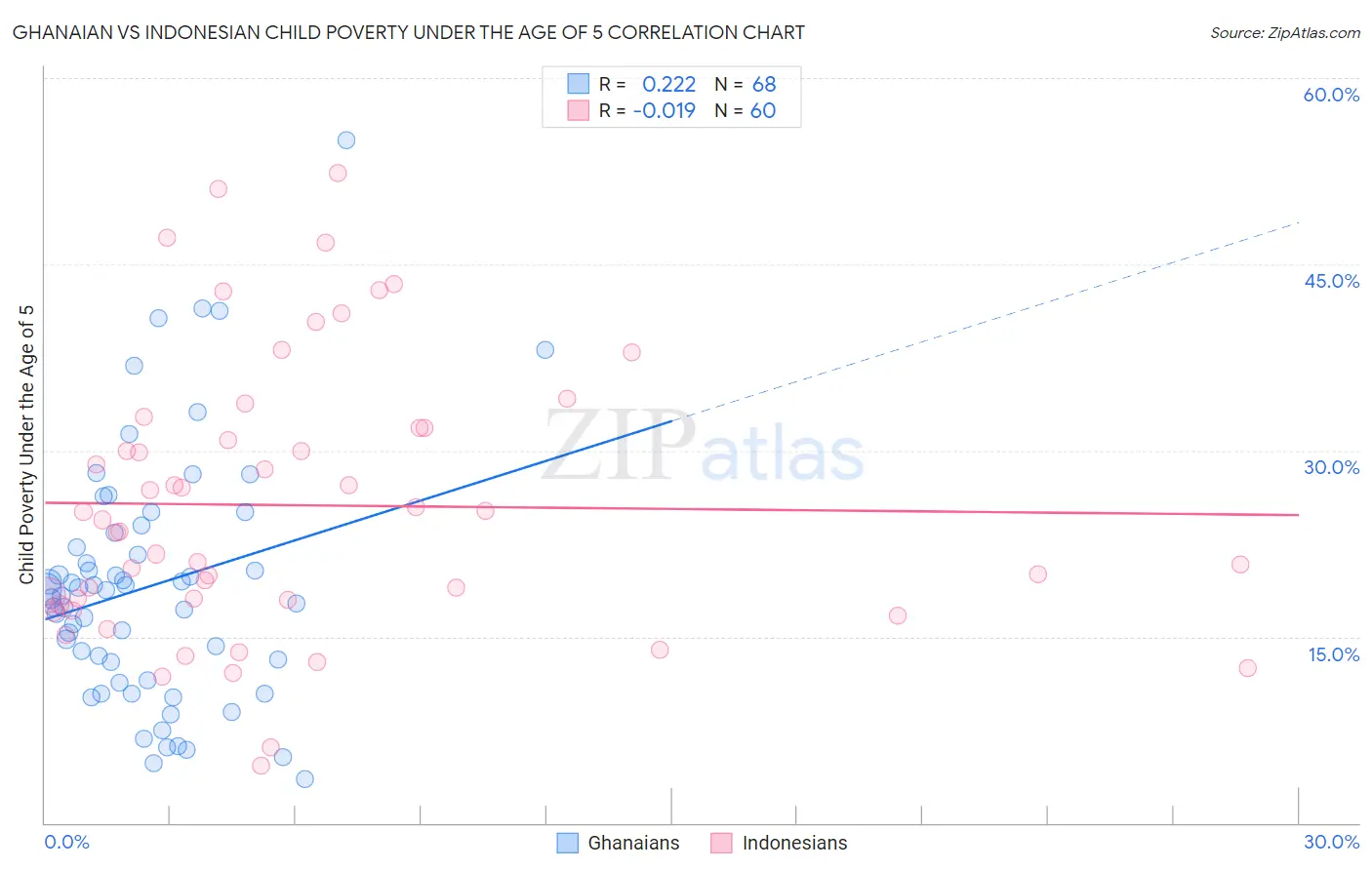Ghanaian vs Indonesian Child Poverty Under the Age of 5
COMPARE
Ghanaian
Indonesian
Child Poverty Under the Age of 5
Child Poverty Under the Age of 5 Comparison
Ghanaians
Indonesians
19.2%
CHILD POVERTY UNDER THE AGE OF 5
1.2/ 100
METRIC RATING
229th/ 347
METRIC RANK
22.3%
CHILD POVERTY UNDER THE AGE OF 5
0.0/ 100
METRIC RATING
306th/ 347
METRIC RANK
Ghanaian vs Indonesian Child Poverty Under the Age of 5 Correlation Chart
The statistical analysis conducted on geographies consisting of 187,226,177 people shows a weak positive correlation between the proportion of Ghanaians and poverty level among children under the age of 5 in the United States with a correlation coefficient (R) of 0.222 and weighted average of 19.2%. Similarly, the statistical analysis conducted on geographies consisting of 159,867,886 people shows no correlation between the proportion of Indonesians and poverty level among children under the age of 5 in the United States with a correlation coefficient (R) of -0.019 and weighted average of 22.3%, a difference of 15.9%.

Child Poverty Under the Age of 5 Correlation Summary
| Measurement | Ghanaian | Indonesian |
| Minimum | 3.5% | 4.6% |
| Maximum | 55.0% | 52.3% |
| Range | 51.4% | 47.8% |
| Mean | 19.1% | 25.6% |
| Median | 18.5% | 24.0% |
| Interquartile 25% (IQ1) | 12.3% | 17.8% |
| Interquartile 75% (IQ3) | 22.8% | 31.8% |
| Interquartile Range (IQR) | 10.5% | 14.0% |
| Standard Deviation (Sample) | 10.0% | 11.1% |
| Standard Deviation (Population) | 9.9% | 11.0% |
Similar Demographics by Child Poverty Under the Age of 5
Demographics Similar to Ghanaians by Child Poverty Under the Age of 5
In terms of child poverty under the age of 5, the demographic groups most similar to Ghanaians are Ecuadorian (19.2%, a difference of 0.040%), Immigrants from Sudan (19.2%, a difference of 0.080%), Bermudan (19.2%, a difference of 0.090%), Cape Verdean (19.1%, a difference of 0.38%), and Immigrants from Eritrea (19.1%, a difference of 0.57%).
| Demographics | Rating | Rank | Child Poverty Under the Age of 5 |
| Alsatians | 1.7 /100 | #222 | Tragic 19.1% |
| Cubans | 1.7 /100 | #223 | Tragic 19.1% |
| Nicaraguans | 1.6 /100 | #224 | Tragic 19.1% |
| Nigerians | 1.6 /100 | #225 | Tragic 19.1% |
| Immigrants | Eritrea | 1.5 /100 | #226 | Tragic 19.1% |
| Cape Verdeans | 1.4 /100 | #227 | Tragic 19.1% |
| Immigrants | Sudan | 1.3 /100 | #228 | Tragic 19.2% |
| Ghanaians | 1.2 /100 | #229 | Tragic 19.2% |
| Ecuadorians | 1.2 /100 | #230 | Tragic 19.2% |
| Bermudans | 1.2 /100 | #231 | Tragic 19.2% |
| Trinidadians and Tobagonians | 0.9 /100 | #232 | Tragic 19.3% |
| Sudanese | 0.9 /100 | #233 | Tragic 19.3% |
| Immigrants | Micronesia | 0.9 /100 | #234 | Tragic 19.4% |
| Immigrants | Laos | 0.8 /100 | #235 | Tragic 19.4% |
| Immigrants | Trinidad and Tobago | 0.8 /100 | #236 | Tragic 19.4% |
Demographics Similar to Indonesians by Child Poverty Under the Age of 5
In terms of child poverty under the age of 5, the demographic groups most similar to Indonesians are Immigrants from Mexico (22.2%, a difference of 0.060%), Immigrants from Guatemala (22.0%, a difference of 0.92%), Inupiat (22.0%, a difference of 1.0%), Iroquois (22.0%, a difference of 1.1%), and Immigrants from Central America (22.0%, a difference of 1.3%).
| Demographics | Rating | Rank | Child Poverty Under the Age of 5 |
| Chickasaw | 0.0 /100 | #299 | Tragic 21.8% |
| Alaskan Athabascans | 0.0 /100 | #300 | Tragic 21.8% |
| Immigrants | Central America | 0.0 /100 | #301 | Tragic 22.0% |
| Iroquois | 0.0 /100 | #302 | Tragic 22.0% |
| Inupiat | 0.0 /100 | #303 | Tragic 22.0% |
| Immigrants | Guatemala | 0.0 /100 | #304 | Tragic 22.0% |
| Immigrants | Mexico | 0.0 /100 | #305 | Tragic 22.2% |
| Indonesians | 0.0 /100 | #306 | Tragic 22.3% |
| Immigrants | Bahamas | 0.0 /100 | #307 | Tragic 22.7% |
| Immigrants | Dominica | 0.0 /100 | #308 | Tragic 22.7% |
| Houma | 0.0 /100 | #309 | Tragic 22.7% |
| Africans | 0.0 /100 | #310 | Tragic 22.8% |
| Seminole | 0.0 /100 | #311 | Tragic 22.8% |
| Hondurans | 0.0 /100 | #312 | Tragic 23.0% |
| Bahamians | 0.0 /100 | #313 | Tragic 23.0% |